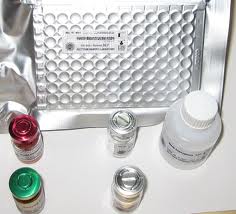
Product name:Casein
CAS:9000-71-9
Molecular Formula:C47H48N3NaO7S2
Specification:500g
Description:
Casein is the predominant phosphoprotein (αS1, αS2, β, κ) that accounts for nearly 20% of proteins in cow milk and cheese. Milk-clotting proteases act on the soluble portion of the caseins, K-Casein, thus originating an unstable micellar state that results in clot formation. Casein is not coagulated by heat. It is precipitated by acids and by rennet enzymes, a proteolytic enzyme typically obtained from the stomachs of calves. The enzyme trypsin can hydrolyze off a phosphate-containing peptone.
It is used to form a type of organic adhesive.
Casein is a white to yellowish particle, powder, or flake. Odorless, tasteless or with a slight aroma and taste. Insoluble in water and alcohol. Caseinate is dissolved in alkali solution. The isoelectric point is pH 4.6. If the residual reducing sugar (lactose) is left in the manufacturing process due to insufficient washing, maillard reaction with Casein can cause Browning.
Production method of Casein :(1) skim fresh milk, add acid (lactic acid, acetic acid, hydrochloric acid or sulfuric acid), adjust pH to 4.6, make Casein microcolloidal particles lose charge and coagulate and precipitate. The casein produced in this way is called casein, and it is almost indistinguishable from one type of acid to another. Casein is a white to light yellow powder or grain with a slight milk odor and sour taste. In water only swelling, if the addition of ammonia, alkali and salt, it can be dispersed dissolved in water. Soluble in strong acid, diethanolamine, morpholine, urea, formamide, hot phenol and Turkey red oil. (2) milk reacts with crude rennet to form coagulated precipitate, which is called crude rennet casein. It is white and granular, almost tasteless and odorless. Heating and burning will produce unique odor. Rennet casein has higher ash content than acid casein.

